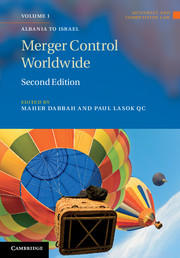Book contents
- Frontmatter
- Contents
- Preface
- List of Contributors
- Table of cases
- Table of Legislation and Official Guidance
- Introduction
- Albania
- Argentina
- Armenia (Republic of Armenia)
- Australia
- Austria
- Barbados
- Belgium
- Bosnia and Herzegovina
- Brazil
- Bulgaria (Republic of Bulgaria)
- Canada
- Chile
- China*
- Costa Rica
- Croatia
- Cyprus (Republic of Cyprus)
- Czech Republic
- Denmark
- Estonia
- European Economic Area
- European Union
- Finland
- France
- Germany (Federal Republic of Germany)
- Greece
- Hong Kong
- Hungary
- Iceland
- India
- Indonesia (Republic of Indonesia)
- Ireland
- Israel
- Italy
- Japan
- Kenya
- Korea
- Latvia
- Lithuania
- Macedonia (Republic of Macedonia)
- Malta
- Mexico
- Netherlands (The Netherlands)
- New Zealand
- Norway
- Pakistan
- Peru
- Philippines (Republic of the Philippines)
- Poland
- Portugal
- Romania
- Russia
- Serbia
- Singapore
- Slovakia (Slovak Republic)
- Slovenia
- South Africa
- Spain
- Sri Lanka
- Sweden
- Switzerland
- Taiwan
- Thailand
- Tunisia (Republic of Tunisia)
- Turkey
- Ukraine
- United Kingdom
- United States of America
- Uzbekistan
- Venezuela
- Zambia
- Index
Introduction
Published online by Cambridge University Press: 05 November 2014
- Frontmatter
- Contents
- Preface
- List of Contributors
- Table of cases
- Table of Legislation and Official Guidance
- Introduction
- Albania
- Argentina
- Armenia (Republic of Armenia)
- Australia
- Austria
- Barbados
- Belgium
- Bosnia and Herzegovina
- Brazil
- Bulgaria (Republic of Bulgaria)
- Canada
- Chile
- China*
- Costa Rica
- Croatia
- Cyprus (Republic of Cyprus)
- Czech Republic
- Denmark
- Estonia
- European Economic Area
- European Union
- Finland
- France
- Germany (Federal Republic of Germany)
- Greece
- Hong Kong
- Hungary
- Iceland
- India
- Indonesia (Republic of Indonesia)
- Ireland
- Israel
- Italy
- Japan
- Kenya
- Korea
- Latvia
- Lithuania
- Macedonia (Republic of Macedonia)
- Malta
- Mexico
- Netherlands (The Netherlands)
- New Zealand
- Norway
- Pakistan
- Peru
- Philippines (Republic of the Philippines)
- Poland
- Portugal
- Romania
- Russia
- Serbia
- Singapore
- Slovakia (Slovak Republic)
- Slovenia
- South Africa
- Spain
- Sri Lanka
- Sweden
- Switzerland
- Taiwan
- Thailand
- Tunisia (Republic of Tunisia)
- Turkey
- Ukraine
- United Kingdom
- United States of America
- Uzbekistan
- Venezuela
- Zambia
- Index
Summary
Overview
Merger control can take various forms. In general terms, a basic distinction is to be drawn between forms of control that are concerned essentially with the processes by which mergers and take-overs occur and those forms that are concerned with the merger itself. The first are typified by the systems existing in various jurisdictions for the regulation of financial and securities markets. Those forms of control are not covered in this publication. As their nature indicates, the predominant (if not sole) objectives of such forms of control are the protection of shareholders and the provision of an orderly framework for the conduct of transactions, usually on a stock exchange, that lead to a take-over or merger. The second forms of control, those that are discussed in this work, are designed to achieve public policy objectives concerned with the shape and structure of industry within a particular jurisdiction. They focus on the commercial and economic consequences of a merger rather than on the processes by which the merger is brought about. In general terms, such forms of control can be said to be motivated by competition policy or industrial policy considerations; and, for obvious reasons, they have tended to come into existence when the economies of the states concerned, and social and political conditions, have reached a certain point in their development at which changes in the shape and structure of industry become an issue either for purely internal reasons or else because of the place (actual or desired) occupied by the states concerned in international trade.
The global development of merger control
Merger control (in the sense relevant to this work) can be traced back at least as far as the early years of the twentieth century – but as the exception rather than the rule: it did not feature in the laws of most developed, market economies until relatively late in that century. Even in the case of economies with well-established competition law regimes, merger control (by means of provisions specifically directed to the peculiarities of mergers) was a late arrival. During the past two decades or so, however, there has been a material change in the profile of merger control law internationally as a result of the phenomenal increase in the significance and geographical scope of competition (or antitrust) law.
- Type
- Chapter
- Information
- Merger Control Worldwide , pp. 1 - 34Publisher: Cambridge University PressPrint publication year: 2012



